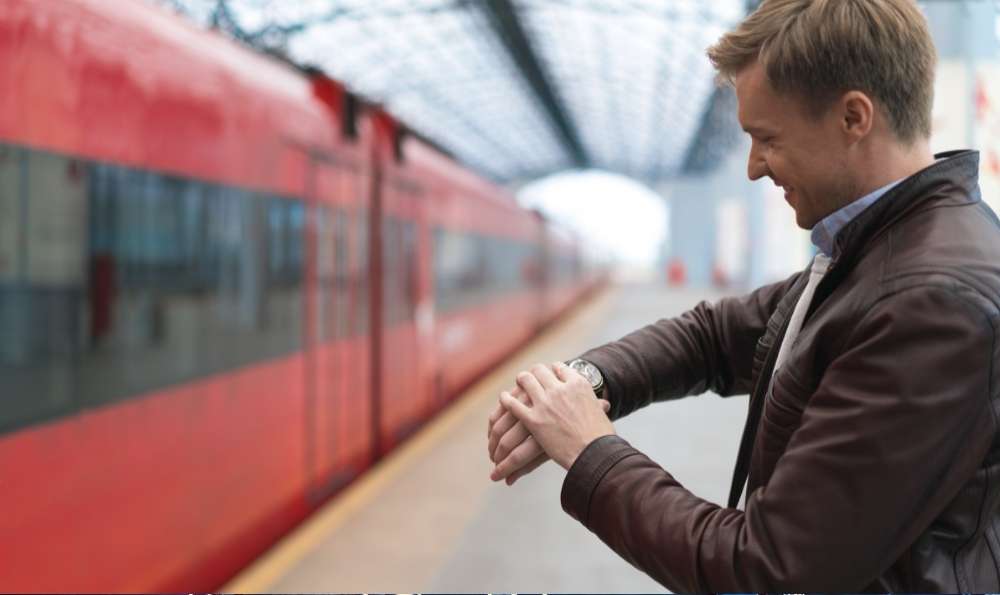As urban density rises globally, with the total amount of urban kilometers travelled by passengers expected to triple by 2050, rail is increasingly being viewed as the mobility backbone of the future. At the same time, the perceived urgency for action on climate change is incentivizing rail investment worldwide.
Rail is considered one of the most energy-efficient means of transportation, with both passenger and freight accounting for only two percent of total transport energy demand. According to the International Energy Agency, rail transport daily consumes only 0.6% of global oil consumption and a little over 1% of global electricity usage. It is also responsible for only 0.3% of global carbon emissions. Shifting passenger transport from energy-consuming cars and airplanes to rail significantly decreases net energy use and carbon emissions, helping mitigate the effects of climate change.
Passenger rail’s high capacity likewise accommodates increasing populations while helping to ease congestion, making rail travel fast and convenient for all. It is not surprising that new metro systems have opened in more than 40 cities since 2010 and new light rail systems have been launched in 65 cities worldwide.
Because rail moves large volumes of people at faster speeds, and maximizes land use, it generates wider economic benefits. A 2016 survey of transport professionals, conducted by the University of Illinois at Chicago’s Urban Transportation Center, for instance, found that transit workers believe significant passenger rail investment in the US leads to greater productivity, higher property values, and reduced costs to other transportation modes. A 2017 study for the UK’s railway companies estimated that a GBP50 billion rail investment into the 2020s can yield around GBP84 billion of additional economic benefits to the country.
A look at rail Down Under
During a recent tour of Australian transit agencies, Trapeze Vice-President for Business Development, Paul Comfort, experienced for himself how mass rail transit invigorates huge metropolitan areas. Paul spent a week meeting with top transit leaders Down Under, including Jeroen Weimar, CEO of Public Transport Victoria (PTV), Nicolas Gindt, CEO of Keolis Downer, who oversees Yarra Trams in Melbourne, and Raymond O’Flaherty, CEO of Metro Trains Melbourne (MTM), to learn how Australian agencies address increasing mobility demands (US agencies can gain more valuable insights from these three transit chiefs on how to utilize Australia’s lessons for America in our award-winning podcast series here).
He noted, in an article in Mass Transit, that the buzz around newer mobility solutions such as Mobility-as-a-Service, autonomous vehicles, and TNCs “aren’t really even registering” in Australia. These were all viewed primarily as first- or last-mile solutions “to get passengers to rail stations or assist them in their rail journeys.”
Instead, what he saw was a keen emphasis on railway development. In fact, while he was in Melbourne, Australia Prime Minister Scott Morrison was in the city announcing a new rail service expansion to the airport. And a day before their meeting, Sydney Trains’ CEO Howard Collins had just led the re-opening of an old rail station in a small town in rural New South Wales. “It appears the nation’s governmental and transit leaders are in agreement that rail mass transit is the best option for moving large amounts of people safely, efficiently and reliably,” writes Paul.
Rail contributes over 26 billion to Australia’s economy, and state and federal governments continue to invest heavily in technology and product development, committing $35.87 billion toward rail expansion projects. In Australia’s big cities, a $6.92 billion National Rail Program has been set up to invest in passenger rail networks. Australia operates the world’s largest light rail system, in Melbourne (245 km.of track), and its rail industry is considered a world leader in innovation.
Australia’s massive rail investment has resulted in state-of-the-art facilities that showcase the local industry’s innovative capabilities. On his tour, Paul also visited Sydney Trains’ new Rail Operations Center (ROC), which has one of the most sophisticated, data-driven, and ergonomically designed Operation Control Centers in the world.
Designed to meet Sydney Trains system’s needs for the next 50 years, ROC serves as a single integrated center with control capability to manage day of operations (DoO) transit service. It houses 104 transit dispatchers/controllers and integrates over 25 functionally different roles. This technically sophisticated building was designed to optimize work performance, with open, curved desks, sit-to-stand workstations, and “front and back” worktops, all enabling easy movement and access.
Its control room boasts of the “WOW” board, the world’s largest operational LED command and control overview display, a 106-foot by 12-foot operational display system that contains 41 million pixels and can show train activity live on the network, displaying images from over 40 sources.
Apart from massive funding, Australia prefers to outsource rail operations to private contractors, using the Design, Build, Operate, Finance and Maintain model of Public Private Partnerships (P3). Actual rail operations in the major cities are operated by private companies under longer-term contracts with state governments. “It appears Australian governments have concluded that the safety, efficiency, reliability, worldwide experience and stable cost projections for future years that is provided by outsourcing operations to major companies for most passenger rail service meets their needs best,” writes Paul in Mass Transit.
Around the world: The regional race for rail is on
Globally, rail infrastructure projects are on the rise. Of the top 100 high-impact infrastructure projects identified by infrastructure strategist CG/LA in its Strategic 100 Global Infrastructure Report, 29 are for passenger rail, with five more for mixed-use heavy rail projects, worth from $.75 billion to $30 billion.
As of July 2017, almost 1,500 rail infrastructure projects were planned or under construction globally, totaling at least $2.1 trillion, according to an International Union of Railways (UIC) analysis, with an additional $80 billion set aside for current rolling-stock procurement.
China, which has the longest high-speed rail of any country and has invested heavily in rail in the past decade, continues to lead the way. Early this year, China announced a record $125 billion rail-investment plan for 2019, six percent more than was spent in 2018, and a 10% increase from initial projections.
Asia leads in rail development, accounting for 60% to 90% of worldwide track being under construction and project budget for most rail types. The only exception is light rail, where Asia only makes up a third of track and investment. China is the main player, responsible for 22% of all heavy rail, 61% of high speed, 66% of metro and 21% of all light rail being built.
In tracks planned, Asia accounts for 90% of metro, indicating high urbanization, and 30% of planned light rail track. Sixty percent of all planned metro tracks are in Chinese cities.
Other Asian countries with significant rail development are India, accounting for 16% of all heavy rail track being constructed, and Turkey, with nine percent of all high-speed track under construction.
Meanwhile, Europe is investing heavily in high-speed rail, with 58% of tracks planned, and, to a lesser degree, in light rail, with 26% of tracks planned.
The US rail investment deficit
Although North America has some of the biggest rail projects in the CG/LA’s Strategic 100 report, notably the planned Pacific Northwest Corridor (project value: $24 billion, US, Canada) Metrolinx/GO Transit’s Regional Express Rail ($10.5 billion, Canada),and the Toronto-Windsor High-Speed Rail ($16.5 billion, Canada), the UIC analysis showed that tracks under construction and projects planned barely amounted to 2,000 km. of track. The report also noted the “exceptionally high costs” of light rail in the US – 35% higher than in Asia and over triple the cost than in Europe.
The US has a massive rail infrastructure backlog that threatens the sustainability of the country’s passenger rail network. The average age of major backlog projects on the Northeast Corridor (NEC), which runs from Boston to Washington, DC, is 111 years old, while the NEC state of good repair backlog is $28 billion, according to the 2017 American Society of Civil Engineers (ASCE) Infrastructure Report Card. NEC needs $11 billion in basic infrastructure funding and $17 billion for major backlog projects.
While Congress is planning to allocate $2.7 billion for passenger rail this year (on top of significant increases for rail in the past two years), concerns for long-term funding to address the backlog have been raised by the transit industry. Amtrak, for example, says it needs more than $30 billion to introduce next-generation, higher-speed service on the Northeast Corridor by 2040.
Not enough to beat climate change?
Globally, investments in high-speed and metro systems comprise 80% of total rail investment, according to the UIC analysis, while there is a substantial deficit in investment for regular rail, particularly commuter rail, which are concentrated in Europe.
UIC concludes that while rail infrastructure is expanding globally to address passenger demand, it may not be enough to meet climate goals. The lack of investment in commuter rail is noteworthy, as it has the potential to maximize energy efficiencies by providing high-capacity transit from city centers to suburban areas. Commuter rail projects in the UIC analysis totaled a little over 1,000 km. and only $57 billion in project value.
With the transportation sector accounting for the largest share of greenhouse gas emissions in the US, at 29%, there is a compelling case for increasingly shifting urban mobility to rail.
Transit agencies, however, face formidable challenges investing in rail, particularly for long-term funding, which would need to address both new capacity and upgrade the aging infrastructure.
Would public-private partnerships be the solution, as it seems to be in Australia? Could it be a matter of actively adopting an asset management mindset? These are critical questions the transit agency should be asking itself, especially at the APTA 2019 Rail Conference. Rail transport was America’s glorious past and certainly could be its excellent future.
Are Public-Private Partnerships the answer? This whitepaper reveals the key things to consider before embarking on a P3, including who really owns your software and data. Get it here.
 Bus
Bus Rail
Rail Paratransit
Paratransit


